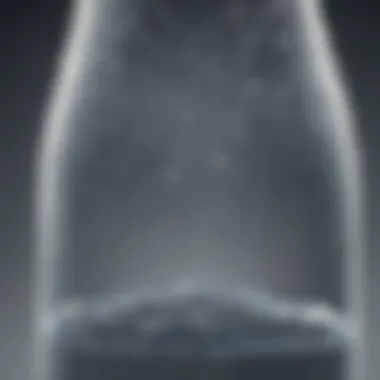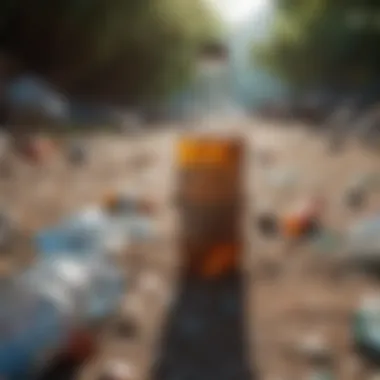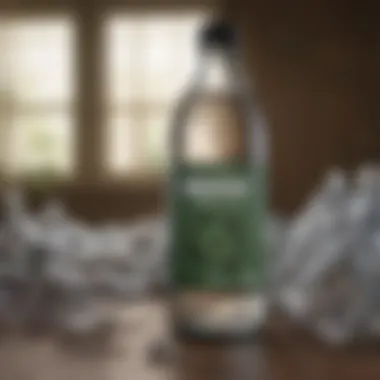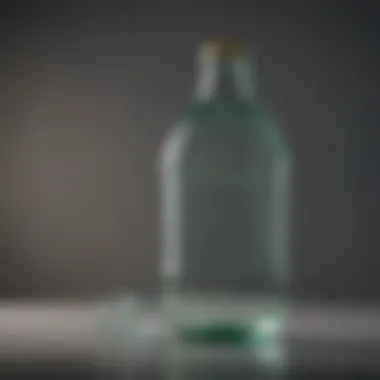Fascinating Insights on Plastic Bottles and Their Impact


Nature Topic Overview
Plastic bottles are everywhere. They are common objects used for many purposes. Understanding what these bottles are made of, how they are used, and what happens to them after we throw them away is vital.
Plastic bottles are generally made from a material called polyethylene terephthalate, or PET. This material is durable and lightweight. These bottles are commonly used for drinks, cleaning products, and other liquids. When we finish our drink, we often toss the bottle into a bin, but this is just the beginning of the bottle's journey.
The lifecycle of plastic bottles is lengthy, starting with their production. They are manufactured in factories, shipped to stores, and sold to customers. After their use, what happens next? Many bottles end up in landfills, while others are recycled. Understanding this lifecycle helps young readers grasp the significance of recycling and proper disposal.
Fun Facts and Trivia
- Bottles Galore: It is estimated that Americans use over 50 billion plastic water bottles each year.
- Recyclable Material: Most plastic bottles can be recycled and turned into new products, such as t-shirts, insulation for jackets, and more.
- Earth's Timeline: A plastic bottle can take up to 450 years to decompose in a landfill. That's a long time!
These facts can inspire curiosity and motivate children to learn more about plastic and its effects on the environment. Visual aids, such as infographics showing recycling processes, can also enhance the learning experience.
Environmental Awareness
Why should we care about plastic bottles? The environment feels its impact all over the planet. Rivers, oceans, and landfills often have a lot of plastic waste. Animals can mistake plastic for food, which can harm them.
There are small but effective way for children to help:
- Always recycle plastic bottles instead of throwing them away.
- Ask for drinks in reusable bottles.
- Participate in local clean-up days to help remove plastic waste from parks and beaches.
"Every small action counts when it comes to protecting our planet."
DIY Nature Activities
Creating awareness is important, but hands-on activities can make learning fun. Here are some activities related to plastic bottles:
- Bottle Bird Feeder: Use an empty plastic bottle and craft a bird feeder. Cut holes, fill it with birdseed, and hang it outside.
- Planter Pots: Turn plastic bottles into small planter pots. Cut the bottles in half, fill them with dirt, and plant seeds. Children can watch their plants grow over time.
- Nature Explorations: Take a walk outside and collect any plastic waste. Engage in a discussion about how it got there and what can be done to help.
Through these activities, children will understand the importance of reducing plastic waste while having fun being creative.
Prologue to Plastic Bottles
Plastic bottles are a prevalent item in modern life. Understanding them is important for appreciating their role in daily activities and their impact on the environment. This understanding helps us make informed decisions about their use and disposal.
Definition and Purpose
A plastic bottle is a container made from plastic. It is typically used to hold liquids, making it a staple in various settings. The main purpose of these bottles is convenience. They are lightweight, durable, and often designed for one-time use. This makes them a practical choice for consumers and manufacturers alike.
As a container, plastic bottles serve specific functions. Their ability to hold beverages allows for easy transport and storage. Furthermore, many plastic bottles are designed to be resealable, which enhances their usability.
Common Uses
Plastic bottles find their place in various industries. They cater to many needs and preferences. Common applications include:
Beverages
Beverages are perhaps the most widespread use of plastic bottles. From water to soda, plastic is chosen for its lightweight and protective qualities. These bottles often have labels that provide essential information on ingredients and nutritional value.
The key characteristic of beverage bottles is that they are usually designed for one-time use. This aspect makes them a popular choice, particularly for on-the-go lifestyles. However, their single-use nature can lead to environmental concerns, which is relevant to this article.
Household Products
Plastic bottles are also common in households. Many cleaning agents and detergents come in plastic containers. Their strength and resistance to breakage make them suitable for storing potentially harmful substances safely.
The unique feature of these household product containers is often a safety cap. While this design makes them safe for storage, it can also complicate recycling processes. When discussing household products, it is essential to consider both convenience and environmental impact.
Personal Care Items


The personal care industry frequently uses plastic bottles for products like shampoos, lotions, and soaps. These bottles are an attractive option due to their versatility in design and size.
A key characteristic of personal care product bottles is their ability to store liquids without leaking. This reliability enhances the user experience. However, the abundance of different plastic types used can cause recycling difficulties.
Composition of Plastic Bottles
The composition of plastic bottles is a crucial aspect of understanding their role in our daily lives. Knowing the materials that make up these bottles and their chemical properties helps to identify their advantages and disadvantages. It also emphasizes the importance of responsible disposal and recycling practices. The main materials used in plastic bottles include Polyethylene Terephthalate (PET), High-Density Polyethylene (HDPE), and other assorted plastics.
Materials Used
Polyethylene Terephthalate (PET)
Polyethylene Terephthalate, commonly known as PET, is a widely used material for plastic bottles. One of its most significant benefits is its lightweight nature. It allows for the easy transportation and handling of beverages. PET is also highly transparent, which makes it visually appealing for consumers. This characteristic is one reason why many beverage companies choose PET for their products. However, the main drawback of PET is its potential to degrade when exposed to high temperatures. This could lead to leaching, making it important for consumers to store drinks properly.
"PET is recyclable and can be turned into new bottles or even clothing fibers."
High-Density Polyethylene (HDPE)
High-Density Polyethylene (HDPE) offers different advantages compared to PET. It is known for its strength and resistance to impact. This makes it a popular choice for household products, like milk jugs and detergent bottles. HDPE is also less sensitive to temperature, which means it can handle a wider range of conditions. One concern, however, is that HDPE is not as widely recycled as PET. Consumers should check local guidelines for its disposal.
Other Materials
Besides PET and HDPE, various other materials are used in plastic bottles, including Polypropylene and various blends. These materials can provide specific benefits, such as improved barrier properties against moisture or gas. Some of these materials are more sustainable, being derived from renewable sources. Nonetheless, they can also present challenges, such as difficulty in recycling or higher production costs. Awareness of these materials is important for understanding the broader implications of plastic bottle usage.
Chemical Properties
The chemical properties of the materials used in plastic bottles play a significant role in their functionality and environmental impact. Both PET and HDPE are known for their durability and resistance to various chemicals. This makes them suitable for a range of liquids. However, it is essential to consider how these properties affect the recycling process. Understanding the chemical stability and potential for degradation can guide better recycling practices and help minimize environmental harm.
Global Statistics on Plastic Bottles
Understanding the statistics related to plastic bottles is essential to grasp their role in our daily lives and the environment. These numbers help us to see the vast scale of production and consumption. This awareness can motivate individuals and communities to take action against plastic pollution. Knowing the amount produced yearly and how much is used helps highlight the urgency of sustainable practices.
Annual Production Rates
Every year, billions of plastic bottles are produced. In fact, over 1 million plastic bottles are purchased every minute around the globe. The primary material used for these bottles is polyethylene terephthalate, also known as PET. This substance is favored for its lightweight and durable properties.
To give perspective, in the year 2021 alone, it is estimated that approximately 500 billion plastic bottles were made. This number is not just staggering; it shows how dependent we are on single-use plastics. Such dependence raises concerns about waste management and environmental impact.
"The production of plastic bottles contributes significantly to global plastic waste, highlighting the need for effective recycling and reduction measures."
Global Consumption Patterns
The consumption of plastic bottles varies greatly from region to region. In developed countries, bottled beverages, especially water and soft drinks, dominate. In contrast, developing nations may see an increase in the use of plastic bottles due to rapid urbanization. People often prefer bottled drinks for convenience and safety, perceiving them as cleaner options than tap water.
Key points about consumption patterns include:
- Beverage Industry: The beverage sector is the largest consumer of plastic bottles, with products ranging from sodas to juices.
- Household Products: Many household products, like cleaning supplies, are also packaged in plastic bottles.
- Personal Care Items: Items such as shampoos and lotions are frequently sold in plastic bottels.
As consumer habits shift, understanding these patterns becomes more crucial. It informs manufacturers and policymakers about trends in consumption and helps shape future sustainability efforts.
Environmental Impact of Plastic Bottles
The environmental impact of plastic bottles is a pressing concern in today's world. Understanding this impact is essential, especially as plastic usage increases globally. Plastic bottles are convenient, but their production, use, and disposal create various environmental challenges.
Pollution and Waste Management
Plastic bottles contribute significantly to pollution. This pollution occurs at various stages: from manufacturing processes that release harmful gases, to littering in our parks and oceans. In many places, plastic bottles end up in landfills where they can take hundreds of years to decompose. When they do break down, they may release toxic substances into the soil and water.
Managing waste properly is crucial. Here are some key points related to waste management:
- Collection: Many cities have systems in place to collect plastic waste, but not all bottles are recycled. It is important for individuals to remember to dispose of bottles in the correct bins.
- Sorting: Once collected, plastic bottles must be sorted from other waste types. Mis-sorted items can lead to more waste.
- Recycling: Recycling can reduce the amount of new plastic produced. This involves processing used bottles into raw materials that can be used to produce new products. Unfortunately, not all bottles are recycled effectively.


The recycling process is not foolproof and often only a fraction of bottles are actually recycled. Thus, understanding proper disposal is vital to reducing pollution.
Effects on Wildlife
Plastic bottles can have devastating effects on wildlife. Animals often mistake plastic for food, leading to ingestion. This can cause serious health issues or even death.
In oceans, marine creatures like turtles and seabirds are particularly vulnerable. They can become tangled in plastic debris or ingest plastic particles, leading to starvation or internal injuries. Here’s how plastic bottles affect wildlife:
- Ingestion: Animals confuse plastic for food, thinking it is something edible.
- Entanglement: Larger plastic remnants can ensnare creatures, restricting their movement.
- Habitat Disruption: Bottles and other plastic waste can destroy natural habitats, making it difficult for wildlife to thrive.
Protecting wildlife requires us to take action against plastic pollution. Reducing our use of plastic bottles and ensuring proper disposal helps safeguard marine life and ecosystems.
Recycling Plastic Bottles
Recycling plastic bottles is a critical aspect of environmental sustainability and waste management. As plastic bottles are ubiquitous, their recycling helps reduce pollution and conserves natural resources. The process makes it possible to reuse the materials, decreasing the need for new plastic production. Understanding recycling is essential for making informed decisions about usage and disposal.
Recycling Process
Collection
Collection is the first step in recycling plastic bottles. This process involves gathering used plastic bottles from various sources, such as homes, schools, and businesses. The efficiency of this stage is crucial because it directly impacts the quantity of materials available for recycling. Many communities provide designated recycling bins to encourage proper disposal. These bins simplify the collection process, making it a popular choice for environmentally conscious individuals. However, not all regions have access to convenient collection services, leading to improper disposal practices.
Sorting
Once collected, plastic bottles go through a sorting process. This involves separating plastics based on type and color. Efficient sorting ensures that each type of plastic is recycled correctly and can be remade into new products. The key characteristic of sorting is its role in maximizing the amount of plastic that can be effectively recycled. It is beneficial in maintaining the quality of recycled materials. One downside is that the sorting process can be labor-intensive and may introduce delays in the overall recycling timeline.
Processing
Processing follows sorting and is where the real transformation occurs. During this stage, sorted plastic bottles are cleaned, shredded, and melted down. New plastic pellets are then created from the melted plastic. This step is significant because it turns waste into a usable resource, helping reduce landfill waste. Processing is advantageous as it generates materials that can be used to make new products, thus supporting a circular economy. However, this stage requires energy and can produce emissions if not managed properly.
Challenges in Recycling
While recycling plastic bottles offers numerous benefits, there are challenges that must be addressed. Common issues include contamination from food remnants, insufficient facilities, and lack of public awareness. Many people do not separate recyclable materials effectively, which complicates the recycling process.
- Contamination - Food and liquids left in bottles can spoil the recycling stream.
- Infrastructure - Some areas lack advanced recycling facilities, limiting capacity.
- Awareness - Many individuals are not informed about proper recycling procedures.
Addressing these challenges requires community effort and education. Reducing plastic waste starts with understanding recycling. Individuals can play a part in promoting a more sustainable future.
Innovations in Plastic Waste Reduction
Reducing plastic waste is increasingly important in our society. Innovations play a crucial role in this area by providing new solutions that seek to lessen the negative impact of plastic. The ongoing problem of plastic pollution calls for imaginative approaches. Through these innovations, we can anticipate cleaner environments and better management of materials we use daily. This section will discuss alternative materials and biodegradable plastics as significant advancements.
Alternative Materials
Alternative materials are those that can replace conventional plastics. These materials can be made from plant-based sources, such as corn or sugarcane. They offer similar properties to traditional plastics but often have a smaller carbon footprint. The benefits of using alternative materials include:
- Lower Environmental Impact: Many alternative materials are renewable and lead to less pollution.
- Reduced Dependence on Fossil Fuels: Using these materials helps to decrease reliance on petroleum-based resources.
However, some considerations must be made. Not all alternatives offer the same durability or functionality as traditional plastics. Also, the processes for creating these materials might still involve environmentally harmful practices. A balance must be achieved between performance and sustainability.
Biodegradable Plastics
Biodegradable plastics are designed to break down more quickly than conventional plastics. They can decompose naturally when exposed to the right conditions, thus reducing their time in landfills. Some essential points regarding biodegradable plastics include:
- Types of Biodegradable Plastics: These can be made from natural sources or through chemical processes that allow faster decomposition.
- Environmental Benefits: By breaking down more quickly, they help lessen the burden of plastic waste in our ecosystems.
Despite the advantages, it is also important to understand that biodegradable plastics require specific conditions to break down effectively. If they end up in the wrong environment, they may not fulfill their promise of reducing waste.
The shift towards innovative alternatives and biodegradable options represents a pivotal change in our approach to managing plastic waste.
Societal Responses to Plastic Pollution


Societal responses to plastic pollution play a crucial role in addressing the environmental challenges posed by plastic waste. Governments, communities, and individuals have begun to recognize the urgent need to mitigate the impacts of plastic pollution. Understanding these responses helps reveal the effectiveness of various strategies, and their relevance in the broader conversation on sustainability.
Government Regulations
Government regulations are essential in the fight against plastic pollution. Many countries have enacted laws to restrict the production and use of single-use plastics. These laws aim to decrease plastic waste at its source. For instance, bans on plastic bags have been implemented in various regions. This encourages consumers to seek alternatives like reusable bags.
Some key regulations include:
- Taxes on single-use plastics: Governments may impose fees to discourage their use.
- Mandatory recycling programs: These programs are designed to improve recycling rates among consumers.
- Promotion of biodegradable materials: Laws may encourage businesses to switch to more sustainable options.
These regulatory measures can reduce the amount of plastic that ends up in landfills and oceans. However, the effectiveness of these regulations largely depends on public compliance and enforcement.
Community Initiatives
Communities are also stepping up to address plastic pollution. Grassroots initiatives often bring awareness and practical solutions to local problems. Groups of volunteers frequently organize clean-up events to remove plastics from parks and waterways. These actions not only help the environment but also promote community engagement.
Here are some common community initiatives:
- Educational campaigns: Schools and organizations run programs that teach about the impacts of plastic waste and how to reduce it.
- Plastic-free challenges: Involving community members in challenges that promote living without single-use plastics for a limited time.
- Local recycling programs: Tailored approaches to ensure that everyone understands how to recycle effectively within their area.
Communities can inspire change by working together on these initiatives. Activism at this level demonstrates how the collective actions of individuals can lead to substantial progress against plastic waste.
"Every small action contributes to a larger movement towards sustainability. It is every individual’s responsibility to play their part."
In summary, societal responses to plastic pollution combine government regulations and community initiatives to create a multifaceted approach. These efforts underscore the importance of collective action and responsibility in tackling one of the pressing environmental issues of our time.
The Future of Plastic Bottles
Understanding the future of plastic bottles is crucial in the current context of environmental sustainability and waste management. The growth of concerns relating to plastic pollution has prompted action from various sectors, including businesses and governments. Exploring this topic unearths trends and practices that aim to make plastic bottles more sustainable, enhancing their utility while reducing their negative impact on the environment.
Emerging Trends
The landscape of plastic bottling is changing due to various emerging trends. Some of these trends include:
- Increased Use of Recycled Materials: Companies are beginning to incorporate recycled PET (rPET) in their bottle production. This not only reduces the need for new plastic but also helps in managing waste.
- Technology in Production: Advanced technologies are being employed to make the production process more efficient, reducing energy consumption and waste.
- Shift to Eco-friendly Packaging: Many brands are introducing packaging made of materials that are biodegradable or compostable. This change is a response to consumer demand for more environmentally friendly options.
- Smart Bottles: Innovations such as smart bottles with tracking systems are gaining popularity. These can help consumers track their water intake or alert them when it is time to refill.
These trends highlight a collective movement towards making plastic bottles less harmful and more beneficial for our planet.
Sustainable Practices
Sustainability in plastic bottles can take many forms. Here are key sustainable practices being adopted:
- Implementing Closed Loop Systems: Some brands are creating a closed loop system, where used bottles are collected, cleaned, and reused in the production of new bottles. This significantly cuts down on waste.
- Encouraging Consumer Participation: Brands are now engaging consumers in recycling initiatives, offering incentives for returning bottles and ensuring they are processed properly.
- Promoting Awareness: Educational campaigns aim to inform the public about responsible disposal and the benefits of recycling. This is essential for increasing participation in recycling programs.
In essence, the future of plastic bottles revolves around innovations that mitigate environmental impact while still serving their original purpose. The integration of advanced technologies and sustainable practices is a shift towards a more responsible approach in dealing with plastic waste.
Rather than allowing plastic bottles to be discarded carelessly, initiatives aim to reframe their lifecycle, encouraging recycling and responsible consumption.
Understanding these trends and practices can arm not just individuals but also communities with the knowledge to be part of the solution, fostering a culture that values sustainability.
Finale
In this article, we explored the intricate world of plastic bottles and their impact on our environment and society. Understanding the lifecycle of plastic bottles is crucial because it highlights both their convenience and the importance of responsible usage. Nowadays, plastic bottles are everywhere. They serve practical purposes for beverages, household products, and personal care items. However, this convenience often comes with significant environmental challenges.
Summary of Key Insights
- Composition: We learned that plastic bottles are primarily made from materials like Polyethylene Terephthalate (PET) and High-Density Polyethylene (HDPE). These materials can be recycled, but their disposal requires attention.
- Environmental Impact: The pollution caused by plastic bottles severely affects wildlife. This impact emphasizes the need for better recycling practices and responsible disposal.
- Recycling: The recycling process is not perfect, fraught with challenges such as contamination and inefficiencies in sorting. Understanding these issues is essential for enhancing recycling effectiveness.
- Societal Responses: Governments and communities are moving to tackle plastic pollution. By implementing regulations and initiatives, they are fostering a culture of sustainability.
Through these insights, readers are encouraged to reflect on their choices. Our understanding of plastic bottles connects to larger themes of consumption and responsibility.
Call to Action for Readers
As you finish reading, consider your daily actions regarding plastic bottles. Here are a few steps you can take:
- Choose Reusable Options: Whenever possible, opt for reusable water bottles. This simple change can reduce plastic waste significantly.
- Participate in Recycling: Make sure to properly recycle any plastic bottles you use. Familiarize yourself with your local recycling guidelines.
- Support Sustainable Brands: Look for companies that prioritize sustainable practices in their packaging.
- Educate Others: Share what you've learned about plastic bottles with friends and family. Knowledge is a powerful tool in the fight against plastic pollution.
By taking these actions, each reader can contribute to a healthier planet. The small changes we make today can lead to substantial improvements for tomorrow.







